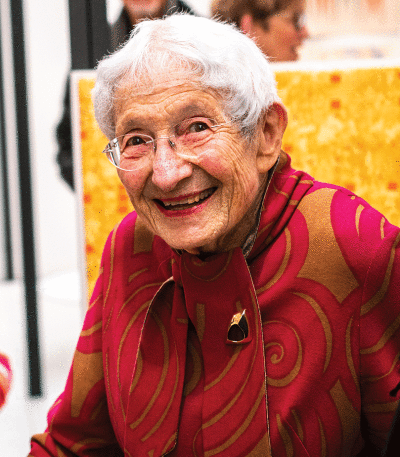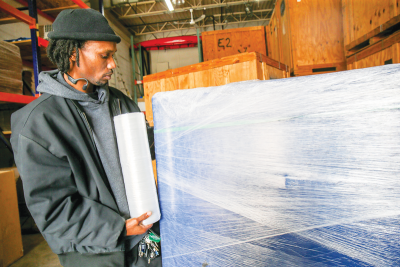
Ruth Adler Schnee was one of the first women to graduate from the Cranbrook Academy of Art.
Photo by Sarah Blanchette

Ruth Adler Schnee’s works with designs for “Slits and Slats and Pits and Pods.”
Photo provided by Cranbrook Archives, Cranbrook Center for Collections and Research
BLOOMFIELD HILLS — Cranbrook Educational Community is remembering the legacy of Detroit textile and interior designer Ruth Adler Schnee following her passing.
Adler Schnee passed away Jan. 5 at the age of 99.
She is known for having a hand in sculpting the mid-century modern movement with her innovative designs from her career, which spanned seven decades.
Adler Schnee was born to a Jewish family in Frankfurt, Germany, in 1923. Her family settled in Detroit after fleeing to the United States following the Nazis’ Kristallnacht pogrom of 1938.
She studied fashion design at Cass Technical High School before receiving a four-year scholarship to study interior architecture at the Rhode Island School of Design, which she graduated from in 1945.
Following graduation, she accepted a position as an assistant designer in the New York firm of Raymond Loewy; however, she left when she received a fellowship at Cranbrook Academy of Art.
In 1946, she received a master’s of fine art in design from Cranbrook Academy of Art and was one of their first female graduates.
While mid-century modern design is very popular now, this was not always the case. Cranbrook Art Museum Director Andrew Blauvelt said Adler Schnee often credited Cranbrook for helping her succeed in promoting modernism.
“She was part of the early group of people at Cranbrook who were advocating a modern approach to design, architecture and life, and so she had a direct impact locally in the Detroit area,” Blauvelt said.
While Adler Schnee went on to build a beautiful career in textile design, she originally wanted to be an architect. However, as a woman, this was not considered a viable path at the time.
Her career in textiles began after she won the Chicago Tribune’s Design for Better Living competition with her drapery design for a glass-and-steel modern house.
At the time, there were not many modern draperies available, so she sketched her own design for her submission.
Her modern drapery design caught the eye of some people working in automobile showrooms who wanted to explore a more modern look and feel.
When they contacted her about the drapery, the designs were only sketches, so she had to figure out how to make screen-printed textiles. This is what launched her into the business of making screen-printed fabrics.
Adler Schnee won several awards early on, including the 1948 American Institute of Designers’ first award in printed fabrics for her design “Strata”; prizes, awards and honorable mentions in many of the Detroit Institute of Arts Michigan Artist-Craftsmen exhibitions; recognition in the University of North Carolina’s International Textile Exhibitions; and selection in the Young Designers competition at the Akron Art Institute in 1954.
In 1948, she opened a design consulting firm and modern design shop in Detroit with her husband, Edward Schnee.
“They were truly pioneers in terms of selling modernism to the public,” Blauvelt said.
Their retail store was known for its unique stock of modern furniture and fabrics, which were not commonly sold at stores during this time. It remained open through the 1970s.
Later on in her career, she won the 2015 Kresge Eminent Artist Award, the Women in the Arts Lifetime Achievement Award, and the American Institute of Architects International Color Award.
Other accolades include an honorary doctorate from the Center for Creative Studies in Detroit that she received in 2010, and solo exhibitions at the Venice Biennale in 2011 and at the Smithsonian in 2012.
Cranbrook Academy of Art presented her with the Distinguished Alumni Award in 2015.
Adler Schnee’s legacy lives on at Cranbrook as they are a major research center for people interested in her work.
The Edward and Ruth Adler Schnee Papers are in Cranbrook Archives’ permanent collection that can be viewed online.
The Cranbrook Art Museum has about 300 examples of her textile designs. The museum’s exhibition can also be explored virtually at https://cranbrookartmuseum.org.
 Publication select ▼
Publication select ▼























